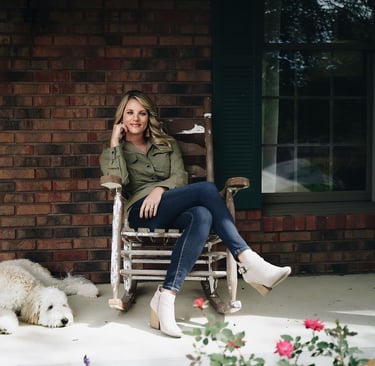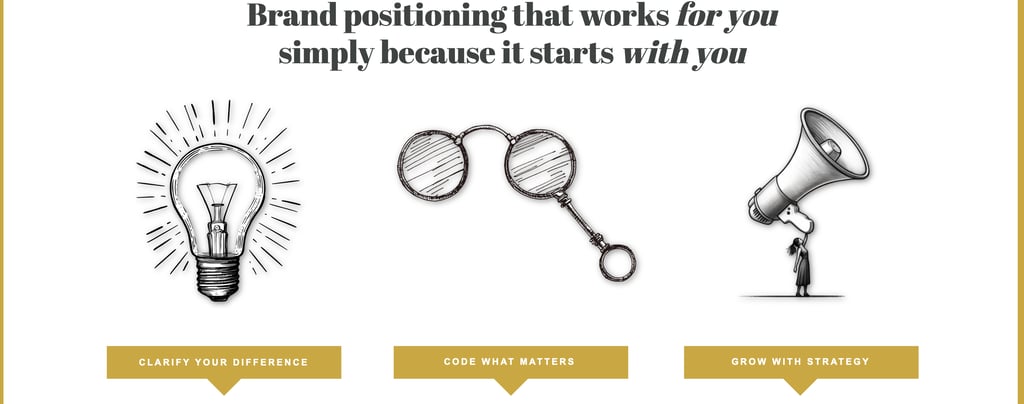Humanizing Your Brand from the Inside Out
Discover how to clarify your brand identity, align your values, and build a more human brand. In this interview, strategist Lindsay Hotmire shares practical insights for nonprofits and founder-led businesses ready to grow with purpose.
Lindsay Hotmire
10/28/202511 min read


What is Brand Identity, and Why Does it Matter?
When most people hear the term “brand identity,” they think of logos, fonts, or maybe a catchy tagline. But brand identity goes much deeper than aesthetics. It’s not just about how your organization looks—it’s about how people experience you. How they feel when they engage with your mission. What they become when they choose to join you.
For nonprofits and founder-led businesses, brand identity is foundational. And if you’re unclear about your brand, you’re likely unclear in your marketing, your fundraising, and your leadership.
To help us dig deeper into this topic, I sat down with a thoughtful, trusted voice in the branding world: Lindsay Hotmire.
Lindsay Hotmire is a storyteller, strategist, and brand consultant for small businesses doing meaningful work. With nearly two decades of experience in education, nonprofit leadership, and marketing, she brings a unique depth to her work.
Lindsay launched her business in 2016 after seeing too many founder-led brands stuck in copycat strategies that didn’t reflect who they really were. Her work now centers on helping clients align their internal culture with external messaging through what she calls the Inside/Out Method™.
Whether she’s guiding teams through brand immersions, culture coding, or deep values exploration, Lindsay’s goal is always the same: to help brands become (not just look) the part. Her work is honest, introspective, and unafraid to push past surface-level positioning to uncover the sacred core of a brand’s identity.
Here's our conversation:
Q: For readers who may not know you, can you share a bit about your background and how you got started?
Before becoming a business owner, I had spent almost 20 years in the worlds of education, non-profit leadership, and marketing. I had seen firsthand the redemptive and transformative power of story – not to just change the trajectory of organizations, but to also change perspectives and lives.
I became a consultant in 2016 when I realized people needed a more transparent, intentional way to find and share their stories. They didn’t know who they were as a brand. They weren’t sure how to position their business in a way that stood them out from their competitors. And I watched how the formulaic options out there were leading people down a sea of sameness and not helping them live out their mission.
I wanted to be a force of change inside a revenue-driven industry. It was a big, idealistic goal – but 10 years later, I can see how I’ve been able to make a difference, one business at a time.
Q: What kind of work do you do at your practice today, and who do you typically serve?
As a brand positioning consultant, I help founder-led businesses who are ready to grow or sell. They are typically small business owners with strong and small teams (50 or fewer employees and an annual revenue of $10M or less). They find me when their old stories are no longer working for them and when they want to connect with the right audience and position themselves (and their mission) for more impact and influence.
Through my brand positioning immersions and culture coding work, I help my clients code the most sacred parts of who they are and then connect their culture to their messaging and their strategic initiatives.


Q: How can small organizations or nonprofits begin clarifying their identity without a huge budget?
We often think that brand identity is who others SEE when they look at us, but I think it’s more than that. It’s how our brand makes others FEEL, too. I always teach that our brands and the stories we tell inside our brands need to answer two questions for our audience: Who are we? And who will I become when I join you?
That first question often feels obvious and easy, but it’s that second question that gets hard. That question is so critical for us to answer, however, because it holds the power and the magic for our brands – because at the crux of the human condition is a longing for transformation.
So, when you’re trying to define a brand, you have to look beyond the traditional marketing pillars and dig deeper, and for me, I delve into four main categories: beliefs, calling, legacy, and community.
Those categories compel us to dive into questions like: Who are we? What do we believe? Who do those beliefs show up in our day-to-day-work? What is our unique contribution to the world? If the work went away tomorrow, why would we keep showing up? Who belongs in our orbit, and who do they become when they join us?
These are the questions I help my clients answer, and those answers reveal the threads that form a brand’s identity.
This work can feel so daunting and difficult when we try to do it on our own. Turns out, that old adage is true: You can’t read the label from inside the bottle. Brand positioning and brand identity work is about broadening of perspective. You have to be willing to see yourself from a different angle, and you have to be willing to expose yourself so that you can be seen.
It’s vulnerable work, and if you’re willing to do it, you find a brand position that becomes your difference maker. You show up in a way that no one else can – simply because you’re showing up with YOUR skills, YOUR gifts, YOUR talents, YOUR unique fingerprint. It’s powerful, powerful work.
Q: What does it mean for a brand to feel "human" rather than corporate or transactional?
I think this question is more important now than it’s ever been, simply because we are careening towards the inhuman at a speed none of us can track with.
AI has leveled the playing field for all of us. It’s no longer enough to show up with a polished message or a flashy website and dazzling marketing. Anyone can do that now, thanks to AI. In a way, this has forced us back to the basics, to the foundations of human connection, and when a business prioritizes the goal of relationship-building, this is when a brand can feel human over corporate and transactional.
I believe that rule-following and formula-making has created dozens and dozens of look-alike brands. Everyone is speaking the same language, spouting the same values, doing the same things, but when someone takes the risk to show up as the outlier – when they just step out and say, “Here we are! This is what we do and here is what we believe!”, they pull others towards them. This is the way of the human, isn’t it? We’re programmed to know what’s real and genuine because for so long, our survival has depended upon this ability, and I think that rule of humanity really is no different for a brand.
Q: How can internal culture and external brand expression reinforce each other instead of competing?
Your external brand expression should ALWAYS be a mirror reflection of what’s happening internally. If it’s anything but that, then you’ve created a false and unsustainable brand.
This is why I rely on my method, the Inside/Out MethodTM to do the reverse of what usually happens in branding. The typical approach for most brands? Define your brand by looking at your competitors and listening to what everyone else is doing. But I say, “Hold up! Let’s understand who YOU are first. Let’s dig into your values, apart from the work. Let’s see how you move through the world. Let’s see your heart.”
I call this your Inside Story. We look at the stories you’re living and the stories you’re telling yourself. Once we’ve adequately covered the Inside Story, then (and only then) we do the external work – looking at the Outside Story by listening to your customers, looking at the competitive landscape, and diving into all that fun brand positioning work.
You build a powerful brand by making sure those two stories match, the inside and the outside story. You have to stand on solid ground and tell stories that are true, so when you use your Inside Story as the compass for everything you do externally, you position yourself to become an authentic and transformational brand.
Q: What advice would you give organizations that feel like their story isn’t compelling or “big” enough?
I love this question because it hits at the heart of where most of us go wrong.
Example: I’ve followed Jesus since I was 6 years old. I remember sitting alone in my grandma’s living room, praying the sinner’s prayer as a televangelist spoke on the TV. I’ve known Jesus for as long as I can remember, and I often lamented as a young adult over the fact that my early decision to follow Jesus meant that I didn’t have this huge, compelling testimony. I didn’t have a BIG Jesus story.
Now that I’m almost 50, I see all of that differently, and I understand that our stories are rarely found in the big moments. Instead, the most powerful moments often take place in the tiny stories of our lives, the ordinary moments that hold the power to connect us to others.
Story isn’t about being big. It’s about connection. People want to know they’re seen, known, and understood. This is the key to transformation.
Q: Are there any simple practices that help a team stay grounded in their brand values day to day?
A simple practice to stay grounded in your brand values is to talk out loud with your team and ask, “How did we live this value out yesterday?” or “When do we compromise this value?”
So many people just name their values and then put them on a website page, thinking that’s enough. But values aren’t meant to be shelved. You have to live them out regularly, and examine yourselves to make sure that’s what’s happening.
Of course, this type of exercise all requires a proper naming of your values – and that’s another conversation for another day. So many people have built their brands around table stakes values, the type of values every human expects you to hold (like honesty and integrity), but core values are different. They don’t change with the times, and they’re never negotiable – and my experience is that most businesses haven’t gone deep enough when it comes to truly understanding what values drive their behaviors. (Hint: If you’ve found and named your values using a values grid, you’ve probably not gone deep enough.)
Values finding is some of my favorite work with clients because it’s always challenging, it’s always growth-inducing, and everything else hinges off of these. You can’t have strong positioning or powerful messaging or even a strong culture if you don’t get this piece right.
Q: What’s one small step a leader can take this week to begin strengthening their brand identity?
The easiest step is to take a look at your brand values and start to be really honest about where and how they’re showing up in your brand (which, I guess, isn’t actually easy work).
One of the things I see business leaders do a lot is to focus on OUTCOMES as values (eg., we’re on time, all the time), but my pushback is always a single question: But why? Why do you prioritize time? Or why do you prioritize excellence? Or why do you prioritize kindness? I push my clients to go deeper into the belief systems that drive their actions and really understand the values that inform what they’re doing. Values are merely a schema to the worldview we hold. They should reflect the parts of us that are unconventional from the rest of the world, and if they don’t do that type of work, then you know you need to go deeper.


Want to Work with Lindsay?
Big thanks to Lindsay for sharing her wisdom. While there’s some overlap in the services we both offer, I don’t believe in competing when it comes to helping others succeed. There’s more than enough room in the marketing and branding world for collaboration—and I’m always happy to highlight other voices doing meaningful work.
If you resonated with Lindsay’s approach to brand identity, I encourage you to reach out. She could be a powerful asset to your organization’s growth and clarity.
You can connect with Lindsay on LinkedIn or visit lindsayhotmire.com to learn more about her consulting services. For direct inquiries, she welcomes emails at lindsay@lindsayhotmire.com.
Let's Stay in Touch
If you enjoy learning about how to market your brand with wisdom and integrity, subscribe to the Mission-Driven Newsletter and receive articles and conversations like this in your inbox each week.

